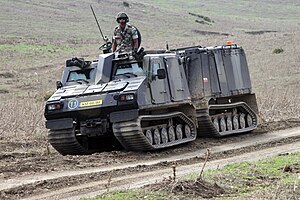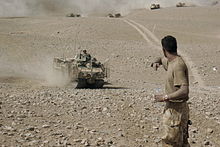| Bandvagn Skyddad 10 | |
|---|---|
 BvS10 of the Netherlands Marine Corps. | |
| Type | Amphibious armoured vehicle |
| Place of origin | Sweden / United Kingdom |
| Service history | |
| Used by | See users |
| Production history | |
| Designer | BAE Systems Land Systems Hägglunds |
| Specifications | |
| Mass | 5.0 t (4.9 long tons; 5.5 short tons) (front car) 3.5 tonnes (rear car, APC version) |
| Length | 8.0 m (26 ft 3 in) |
| Width | 2.25 m (7 ft 5 in) |
| Height | 2.45 m (8 ft 0 in) (front car) 2.1 m (rear car) |
| Crew | driver |
| Passengers | 4 passengers (front car), 8 passengers (rear car) |
| Armour | Basic hull protection against Small-arms fire and artillery threat (STANAG 4569 level 2)
Enhanced protection (option) With add-on up to 14.5 mm. (STANAG 4569 level 4) Liner (optional) Basic protection against smaller AP mines Enhanced protection (option) with Additional deflector plates. |
Main armament | weapons ranging from 5.56mm to 12.7mm, as well as a 40mm automatic grenade launcher. |
Secondary armament | smoke grenade launchers (front), mortars (back) |
| Engine | Cummins 6.7 litre in-line six-cylinder turbocharged diesel 210 kW (285 hk/970 Nm) |
| Transmission | Allison automatic (6 speed forward/1 reverse) |
Operational range | up to 500km |
| Maximum speed | 70 km/h (43 mph) roads 5 km/h (3.1 mph) water |



The BvS10 (Bandvagn Skyddad 10, also known as Bandvagn 410 or BV410) is a tracked articulated amphibious all-terrain armoured vehicle produced by BAE Systems Land Systems Hägglunds of Sweden.[1] This vehicle, referred to as the All Terrain Vehicle (protected) - ATV(P) or Viking by the UK forces, was originally developed as a collaboration between industry - Hägglunds Vehicle AB - and the British Ministry of Defence (MoD) on behalf of the Royal Marines.
The BvS10 is similar to, but distinct from, Hägglunds earlier Bandvagn 206 or Bv 206S. It is a much larger vehicle based upon the characteristic twin-cab, articulated frame-steering system typical of Hägglunds all-terrain vehicles. The main differences from the older Bv206s are a more powerful Cummins 5.9 litre diesel engine, improved ground clearance, and newly developed chassis, power train and steering units that give the vehicle considerably enhanced speed (up to 65 km/h from the previous 51.5 km/h on road) and comfort on road and in terrain, as well as greater load-carrying capability (up to 5 tons), and the ability to add various modular sub-systems such as add-on armour, weapon mounts, a load-changer and cargo platforms.
- ^ "Kar Leoparı - BVS 10 Kar Üstü Araç (Lisanslı Ürün)" (in Turkish). Archived from the original on 2016-12-20. Retrieved 2016-05-31.